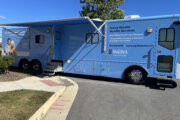In the ever-changing national narrative about how what we eat and drink, and how much, expands our waistlines and jeopardizes our health, a sweet jolt found in everything from soda to spaghetti has fast become a central villain — and many experts say for good reason.
“High sugar intake … increases your risk of all forms of chronic disease,” says Laura Schmidt, a professor of health policy in the School of Medicine at the University of California, San Francisco. That ranges from heart disease to high blood pressure and, of course, diabetes, says Schmidt, who leads a team of scientists from UCSF thatdeveloped SugarScience, a resource compiling the latest research on sugar and its effect on health.
Where fat was once a primary focus, the 2015 Dietary Guidelines for Americans report — which informs guidance that aims to reset the table for a healthy, balanced diet for Americans — has taken aim at the sweet stuff. “The big emphasis is on added sugars,” says Marina Chaparro, a spokeswoman for the Academy of Nutrition and Dietetics. One of the main recommendations, she notes, is to limit consumption of added sugars to 10 percent of our daily calories. That depends on a person’s total caloric intake, and should amount to no more than 6 to 12 teaspoons per day. Instead, she says we’re consuming upwards of 30 teaspoons a day, on average.
Much of that sugar lurks in beverages — comprising more than one-third of the added sugars in the American diet. And it’s not just soda. Experts say added sugars sneak into a great variety of the drinks we consume — from coffee and tea we might consider healthy (with that added kick that’s not caffeine) — as well as unsuspecting foods like yogurt and condiments. One little teaspoon of ketchup can pack 4 grams of added sugar, Chaparro points out — a far cry from the innocent tomato.
Sugar has been transformed from a condiment itself into a dietary staple, Schmidt says: “The [food] industry has done that. It’s hiding in everything.” The Food and Drug Administration is proposing that added sugar be listed on new nutrition facts labeling; current labels showing sugar content don’t distinguish between that which is naturally derived, like lactose from milk, and sugar added to processed foods, for example, to make them more palatable.
So besides looking for those labels in the future, what can we do today to understand how much of the sweet stuff we’re taking in and cut back? Follow these expert tips:
Drink water, or another unsweetened (check the label) beverage. Much of our empty, sugar-soaked calories come directly from what we guzzle. The fix is simple in some respects, like drinking water instead of soda, and extends to coffees and teas purchased on the go, which typically contain sugar. If you can’t forgo a joe, make sure it’s black, or mix in something else that isn’t sweet. Even drinking juice that doesn’t contain added sugar can spike blood sugar, since it concentrates natural sugar, or fructose. So limit consumption — and instead eat the whole fruit from which it was squeezed, Chaparro recommends.
Watch out for added sugar where other ingredients are removed. If something you may consider “bad” — like fat or gluten, both which have gained more defenders of late — has been taken out, it’s likely additional sugar has been put in to improve taste. So aim for a balance, eating healthy fats, like those found in fish, and determining whether a gluten-free diet is right for you — do you really have celiac disease or a gluten intolerance? — before cutting ingredients wholesale, and potentially inviting more sugar into your diet.
If it’s processed, there’s a good chance it’s sweetened. “To the extent that you can, avoid food that comes in boxes, bags and cans,” Schmidt says, since it routinely contains added sugar. Opt instead for whole foods, including nuts, veggies and fruits. An apple, for example, still contains fructose, but experts say it’s much healthier to consume because you also get the fiber and other nutrients, and sugar isn’t concentrated, as in its processed form.
Take a cue from sugar’s ranking on the ingredient label. If you are buying anything from the middle of the grocery store, check the label to see where sugar is positioned relative to other ingredients. Avoid food products that list sugar or some derivative, from dextrose to high fructose corn syrup, as one of the top three or four ingredients, Chaparro says.
Familiarize yourself with the many, many names for sugar. “You need to know the language of sugar,” says Dr. Richard Pratley, medical director of the Florida Hospital Diabetes Institute in Orlando. Given the current obesity epidemic and the many health problems associated with high sugar consumption, experts say that’s true not only for individuals with diabetes, but also the general population. SugarScience lists 61 names for sugar, ranging from barley malt, caramel, dextrin and maltol to panocha, sweet sorghum and treacle. Don’t give more obvious ones like brown sugar and honey a pass, either, Pratley says, though they may wear a “natural” halo. Instead he advises factoring these into your overall sugar-consumption tally: “All these are simple sugars that have the same effect in your body.”
Don’t let raging food debates distract you from practical steps. From a push by some that you cut out all carbs to whether natural sugars, like lactose in milk, are all that bad, there’s no shortage of debate edging common sense off your plate. Still, experts on nearly all sides of the food aisle can agree that certain simple steps, like cutting out sugary beverages and eating more whole foods, and less of the processed stuff, can help keep you pointed in the right direction as you weigh the latest evidence on more nuanced diet issues.
Take care with carbs. As mentioned, there’s plenty of debate here, but many experts say that rather than vilifying carbs altogether or feasting on them with abandon, it’s good to take a circumspect approach to these sugars, starches and fibers found in grains and other foods, such as fruits, veggies and even animal products. “The ones that are less healthy for you … are the ones that are rapidly processed into simple sugars. So those are the starches that are processed into sugar and have what’s called a high glycemic index — that means they cause the blood sugars to go up pretty quickly,” Pratley says, and these range from white bread to rice. He recommends limiting the carb portion of your plate to no bigger than about half a fist, or no more than roughly 45 grams per meal.
Get basic to the basics. With so many words for sugar, so much noise on nutrition and so little traditional American cuisine (nothing akin to the Mediterranean diet, per se) to guide menus and healthy eating habits alike, doing something as seemingly simple on its face as reducing sugar consumption can feel overwhelming. But Pratley says hyper-boiled-down guidance like that penned by food writer Michael Pollan is just what your table and doctor ordered: “Eat food. Not too much. Mostly plants.” It’s great advice, Pratley says, giving his own succinct summary on the sweet nutritional advantages of such a simple approach: “That gives you your complex carbohydrates, it limits the added sugars and avoids high-glycemic foods.”
More from U.S. News
The 10 Best Heart-Healthy Diets
10 Ways to Live Healthier and Save Money Doing It
What Not to Say When Someone Loses Major Weight
Sniffing Out Sugar: How to Cut Back on the Omnipresent Sweet Stuff originally appeared on usnews.com







